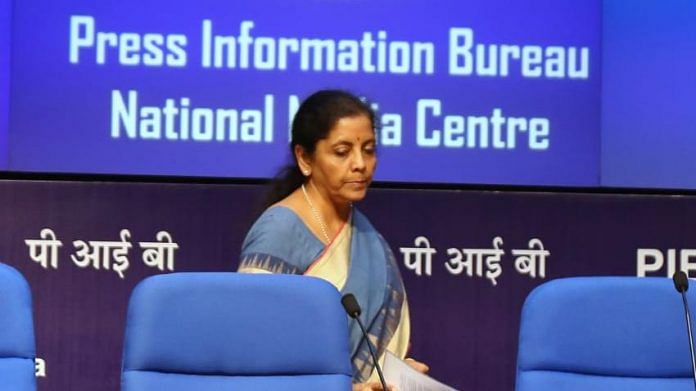Arvind Panagariya | Economics professor, Columbia University
The Times of India
Finance Minister Nirmala Sitharaman’s move to cut corporate tax for domestic companies and manufacturing companies is one of the “boldest reforms in the last 20 years”, writes Panagariya. A similar reform for personal tax could be beneficial as well, given the top effective marginal rate is 43 per cent. High rates and loopholes call for corruption and harassment, and a top personal income tax which matches the corporate profit tax rate at 25 per cent could end this.
If creating jobs is a priority, the government needs to push corporations to spread scarce capital over more work workers, labour reforms are needed for this, he writes.
The cut in corporate tax might result in a revenue loss of up to 0.7 per cent of the GDP. In this scenario, the government should take on “pro-growth reforms” such as the sales of public sector enterprises and monetisation of infrastructure assets such as highways, airports, railway stations etc. These steps will “signal its resolve to move ahead towards a $5 trillion economy”, writes Panagariya.
Himanshu | Economics professor, Jawaharlal Nehru University
The Indian Express
Himanshu writes about the winners of this year’s Nobel Prize in Economics, Abhijit Banerjee, Esther Duflo and Michael Kremer, and their “experimental approach towards lifting poverty” and use of the Randomised Control Trial (RCT) approach.
RCT, a “buzzword among development economists”, essentially examines the impact of particular interventions on the poor in randomised trials. Critics say the approach divorces the study of poverty to “small interventions unconnected to the lived experiences of the poor”. But regardless, the three scholars have been instrumental in putting poverty and development economics “back on the agenda of economics”.
RCT has become a “movement”, encouraging many young economists to immerse themselves in rural areas to understand and observe the lives of the poor. The approach has also given scientific legitimacy to economics because of the evidence generated in such experiments.
The approach could have predicted the effects of demonetisation on the lives of the poor, but such decisions are often based on “the whims and fancies of the government”, he writes.
This Nobel recognition will hopefully motivate the Modi government to “take data and evidence more seriously”, adds Himanshu.
Harsh V. Pant | Director, studies, Observer Research Foundation, and professor, King’s College London
Angad Singh | Project coordinator, Observer Research Foundation
The Hindu
The Rafale jet handover last week was a “milestone” for the Indian Air Force (IAF) — historically one of the strongest equipped forces in the region. In the last two decades, however, it has been losing its quantitative advantage over China and Pakistan. The IAF now has two tasks before it: “to acquire technological superiority” over the neighbours, and enough aircraft to “head off any collusive misadventures”, write the authors.
Technologically, the Rafale jet will bring an “unprecedented” air-to-air capability. India is paying top dollar to Dassault to modify the aircraft to exacting specifications, but also for reliable service — a first-of-its-kind service deal in India, they write.
The IAF can also explore the domestically produced HAL Tejas Light Combat Aircraft as an option to replace the hundreds of aircraft which will be withdrawn from service by 2024-25.
The Pakistan Air Force has similar legacy issues as the IAF, but China’s People’s Liberation Army Air Force (PLAAF) has seen “formidable growth” that cannot be ignored.
Even though the IAF is welcoming new acquisitions, “ad hocism should give way to strategic thinking”, conclude Pant and Singh.
Rural unemployment rises, urban stabilises
Mahesh Vyas | MD and CEO, Centre for Monitoring Indian Economy
Business Standard
Vyas notes that rural unemployment increased above the 8 per cent mark in October. In September, rural unemployment had dropped to a record 6 per cent, which was the lowest this year. The drop was due to “a sharp increase in kharif sowing activities because of a late recovery in monsoon rains”, which increased the demand for labour, he writes.
The reversal of September’s low level of unemployment was expected, but not to this extent. “October is a month of festivals and the demand for casual labour, of the kind that usually gets absorbed in agricultural activities, is expected to remain high.” Thus, according to Vyas, unemployment was expected to rise to around 7 per cent.
In urban India, the unemployment rate is higher: “The average unemployment rate during the first two weeks of October was 9 per cent.” This is slightly lower than the average rates in August and September at 9.6 and 9.7 per cent, respectively. While Vyas notes that the fall is not an “insignificant one”, he acknowledges the need to bring these figures down.
Liberal democracy seems to be poised on a knife-edge
Dani Rodrik | Professor, international political economy, Harvard University
Mint
In his piece, Rodrik explains why liberal democracy is fragile and how civil society constantly plays catch-up with authoritarian leaders to reign in their “despotic tendencies”.
Elaborating on ideas of novelist Mohammed Hanif, and economists Daron Acemoglu and James Robinson, Rodrik identifies two dystopias — centralised state power that leads to despotism, and weak state power that renders anarchy. The middle ground comprises “inclusive institutions” and the rule of law that drives economic and political progress, along with protection of minority rights, he writes.
China defies this — despite corruption and weak political opposition, it has impressively reduced poverty among its people and emerged as a global economic power, explains Rodrik.
Though the US was once considered a prime example of liberal democracy, a look at its skewed income distribution and “brittle” representative political institutions, currently “under attack from a demagogue”, suggest otherwise. What exists is electoral democracy or rather, an “impoverished kind of democracy”, writes Rodrik.



